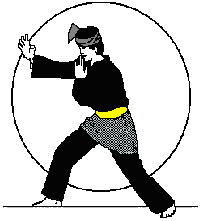



Posted on 9th September 2006.
The Actual World of Silat TechniquesIn the previous articles, I discuss about the Initial Moves prior to applying locks, and 'Application Concepts' in Locks (for lack of a better word). I suppose I should discuss about finishing moves, but I'm not sure if it's necessary. Finishing moves in Silat Seni Gayong PASAK is relatively easy. Either you break the opponent's neck or strike him somewhere. Rather, I would like to discuss how a technique looks like during practise, and how a technique(s) may look like when the technique(s) is actually used.
|
|||||||||||||||||||||||||||
|
|||||||||||||||||||||||||||
|
|||||||||||||||||||||||||||
Consider the following technique: The opponent punches and the exponent locks the opponent's arm as shown. The exponent trips the opponent so that he falls backwards. From here, the exponent ends the lock with a stomp ('Kuncian: TPHP Bengkong Buah 7').
But let just say the the fighters are fighting on a narrow pathway, surrounded by walls on either side. What would the right action for the exponent to doIt will be as shown below:
The exponent would be better off slamming the opponent's head on the wall repeatedly until the opponent can no longer fight.
|
|||||||||||||||||||||||||||
Consider the 'Buah' below. It is part of the description of 'Permainan: TPHP Bengkong Buah 3'.
In a real life situation, the techniques will not be so clear cut. Real fighting is not chereographed, and your opponent will be trying to hurt you. In real life, what is described above may come out to be something like this:
As you can see, the two sets of techniques are different on the surface. But in reality, they are the same. The technique used in the 'Permainan' showcased is actually a throw, or to most martial artist, a 'hip throw'. The technique also shows how to avoid such a throw. The whole idea is to actually practise this movement so well that one can throw his opponent easily, or if one is being thrown with this technique, one would know how to land on one's feet.
|
|||||||||||||||||||||||||||
|
|||||||||||||||||||||||||||
Consider the technique below. It is the main part of 'Kuncian: TPHP Bengkong Buah 1". It is a very basic technique.
Now let us consider a possible real life scenario.
|
|||||||||||||||||||||||||||
|
|||||||||||||||||||||||||||
Why real life fighting is bad (for you, that is)As one can see, the techniques shown here are quite harsh. That is because real life fighting is harsh. Or to use the correct terms; Brutal, even degrading. Silat forms and 'langkah' can give the impression of a dance rather than a martial art. It is a beautiful art, and no doubt it is this 'aethetic' value (did I spell it right?) that attracts some people into the art. But rest assured that when people like Hang Tuah, Datuk Bahaman, or Dol Said fight, they are definitely NOT dancing. Fights are fast and furios, usually last about 3 seconds per opponent. A martial art like Silat, with its long traditions, would not have survived if it is not useful in a real fight. Real life situations are unpredictable. It cannot be accurately duplicated in training. No matter how hard you train, there is still a chance that you will be defeated. In the words of a great martial artist, martial arts cannot make you invincible. It can only give you an advantage (Bill Wallace's words, I think). Another thing about real life fighting is that it is degrading. If you continually get into fights, it will affect you as a human being. It will make you expect to fight wherever you go. This can become some sort of a self-fulfilling prophecy where at first there are no problems, and when you walk into the room with the attitude of 'fight me if you dare', problems (translated to fights) will occur. That's why most good teachers will tell you not to fight if you can help it. It's not for the good of your adversary. It is for your own good. Personally, after Polytechnic I usually walked away from most potential fights. Don't see the point, really.
|
|||||||||||||||||||||||||||
ConclusionThis is the last of 3 articles about real life self defense. I will write some other stuffs in the future. There are a few more topics that I wanted to convey. Please bear with me if you don't fully understand the techniques shown. It is not my purpose to teach you silat techniques. You don't teach silat techniques through a website. My purpose is to convey an idea about real life fighting and how silat training fits into the picture. Also, please do not copy these articles or words from these articles and call it your own. It would be very undignified of you to do that. I hope that you find these articles useful, or at least entertaining. Do give suggestions by signing my guestbook or forum on the main page, but please be polite. MAY PEACE BE UPON YOU. |
|||||||||||||||||||||||||||
| Input your comments about this article here (Click on the PostReply button)
Back to: My Home Page | Other Self-Defense Articles |
|||||||||||||||||||||||||||
|
|